Dear Friends, Find the list of important Reasoning Test Questions 20-20 for upcoming SBI PO and competitive exams. We regularly provide 20 reasoning test questions daily for students. Aspirants practice these questions on a regular basis to improve your score in reasoning section. Aspirants preparing for the exams can make use of this 20-20 Reasoning Questions. SBI PO Prelims 2018 Notification has been released we hope you all have started your preparation. Here we have started New Series of Practice Materials specially for SBI PO Prelims 2018. Aspirants those who are preparing for the exams can use this “20-20” Reasoning Questions.
[WpProQuiz 2436]Click “Start Quiz” to attend these Questions and view Explanation
Click here to view Reasoning Questions in Hindi
Direction (1-5): Read the following information carefully and answer the questions given below.
Seven people Pranesh, Quadir, Ravi, Siddarth, Tarun, Uly and Varun are attending the interview in different days in a week. They are from different cities namely Chennai, Bangalore, Kolkata, Kanpur, Delhi, Patna and Mumbai. The week days starting from Monday to Sunday. All the given information is not necessary in the same order.
The person who is from Kanpur is attending the interview on Saturday. Only two people attend the interview between the person who is from Kolkata and Pranesh. Siddarth is from Bangalore and does not attend the interview any of the days after the person from Kolkata. Pranesh does not attend the interview any of the days after Thursday. The person from Chennai either attends the meeting on Saturday or on Tuesday. More than two people attend the interview between the person from Delhi and Ravi, who attends the interview one of the day after Pranesh. The person from Delhi does not attend the interview any day before the Wednesday. Only two people attend the interview between Tarun and Uly, who is not from Delhi. Varun is neither from Patna nor from Kanpur. The person from Bangalore does not attend the interview on first day of the week. Not more than one person attended the interview between the person from Patna and Ravi.
1). Who among the following person is from Delhi?
a). Uly
b). Varun
c). Ravi
d). Tarun
e). None of these
2). How many people attend the interview between the person from Chennai and Varun?
a). One
b). Two
c). Three
d). More than Three
e). None of these
3). Who among the following person attends the interview on Thursday?
a). Uly
b). Varun
c). Ravi
d). Tarun
e). None of these
4). The person attends interview on Tuesday is from which of the following city?
a). Mumbai
b). Chennai
c). Bangalore
d). None of these
e).Cannot be determined
5). The person from Mumbai attends the interview on which of the following days in a week?
a). Monday
b). Tuesday
c). Wednesday
d). Thursday
e). None of these
Direction (6-10): In the following questions, the symbols !, @, %, & and # are used with the following meanings as illustrated below:
‘A @ B’ means ‘A is greater than B’
‘A # B’ means ‘A is less than B’
‘A % B’ means ‘A is greater than or equal to B’
‘A & B’ means ‘A is less than or equal to B’
‘A ! B’ means ‘A is equal to B’
Give answer,
a). If only Conclusion I follows
b). If only Conclusion II follows
c). If either Conclusion I or Conclusion II follows
d). If neither Conclusion I nor Conclusion II follows
e). If both Conclusion I and Conclusion II follows
6).
Statement: P # L % C & V @ N & R ! S & O
Conclusion:
I). O @ N
II). N ! O
7).
Statement: M & N ! F @ O # P % S & L @ K
Conclusion:
I). M # S
II). N @ K
8).
Statement: P @ L % M ! N % H & B ! V & W
Conclusion:
I). W % H
II). P @ H
9).
Statement: H @ S # O % E ! N & X # L % V @ Q
Conclusion:
I). O @ N
II). Q # L
10).
Statement: P # L ! C # J % I @ U % S & X @ Q
Conclusion:
I). J @ S
II). P ! C
Direction (11-15): Read the following information carefully and answer the questions given below.
Eight people sitting in two parallel rows facing each other. Each row contains five seats and one of the seat is vacant. No two vacant seats in the each row facing each other. In Row-1, A, B, C and D are seated and facing north, while In Row-2, P, Q, R and S are seated and facing south. All the given information is not necessary in the same order.
D sits third to the right of vacant seat. Only one seat is between A and C, who neither faces S nor faces P. R sits second to the left of vacant seat. Only one person sits between S and Q, who does not faces A. Only one person sits between A and B. P does not faces D.
11). Who among the following person faces P?
a). A
b). B
c). C
d). D
e). Vacant
12). Four among the following five are alike in a certain way based on the arrangement. Find the one who does not belong to the group?
a). A
b). P
c). S
d). R
e). D
13). How many seats are there between A and D?
a). One
b). Two
c). Three
d). Cannot be determined
e). None of these
14). Who among the following person faces the person who sits second to the right of A?
a). P
b). Q
c). Vacant
d). S
e). R
15). Who among the following person faces B?
a). P
b). Q
c). Vacant
d). S
e). R
Direction (16-18): Read the following information carefully and answer the questions given below.
‘A @ B’ means ‘B stands 3 meters to the east of A’
‘A # B’ means ‘B stands 3 meters to the west of A’
‘A $ B’ means ‘B stands 3 meters to the north of A’
‘A % B’ means ‘B stands 3 meters to the south of A’
Statement: A @ P $ L $ C @ M $ N; L # F $ U # R $ O # S % D
16). In which direction does F stands with respect to N?
a). Northwest
b). Northeast
c). Southwest
d). Southeast
e). None of these
17). How far and which direction does U stands with respect to A?
a). 6 meters, North
b). 6 meters, South
c). 3 meters, North
d). 3√5 metres, Southwest
e). None of these
18). In which direction does R stands with respect to M?
a). North
b). South
c). East
d). West
e). None of these
Direction (19-20): Read the following information carefully and answer the questions given below.
Seven People P, Q, R, S, T, U and V are in the family. There are two generations and one married couple in a family. P is mother of U, who is only nephew of R. S is the aunt of T. R is the mother of V. S is not a sister of T’s father. Q is the uncle of V and has only one sister.
19). How is T related to Q?
a). Daughter
b). Daughter-in-law
c). Son
d). Niece
e). None of these
20). How is V related to P’s sister?
a). Daughter
b). Niece
c). Nephew
d). Cannot be determined
e). None of these
Answers:
Direction (1-5):
Explanation:
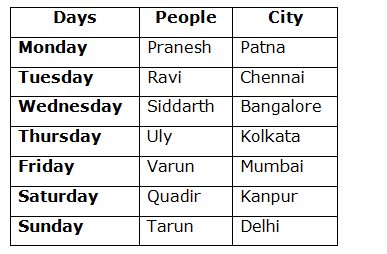
i). The person who is from Kanpur is attending the interview on Saturday.
ii). Only two people attend the interview between the person who is from Kolkata and Pranesh.
iii). Pranesh does not attend the interview any day after Thursday.
iv). Siddarth is from Bangalore, who does not attend the interview any day after the person from Kolkata.
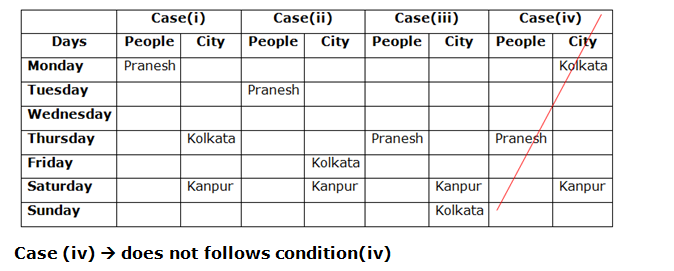
v). More than two people attend the interview between the person from Delhi and Ravi, who attends the interview one of the day after Pranesh.
vi). The person from Delhi does not attend the interview any day before the Wednesday.
vii). The person from Bangalore does not attend the interview on first day of the week.
viii). The person from Chennai either attends the meeting on Saturday or on Tuesday.
ix). Only two people attend the interview between Tarun and Uly, who is not from Delhi.
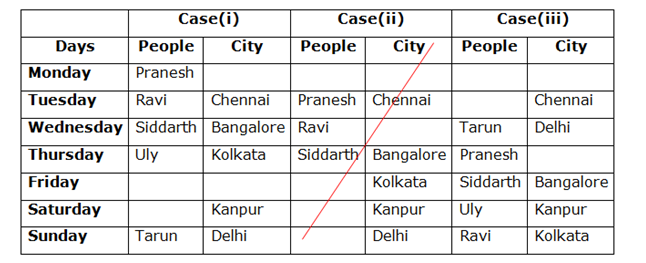
Case(ii) → Does not follows Condition(ix)
x). Varun is neither from Patna nor from Kanpur.
xi). Not more than one person attended the interview between the person from Patna and Ravi.
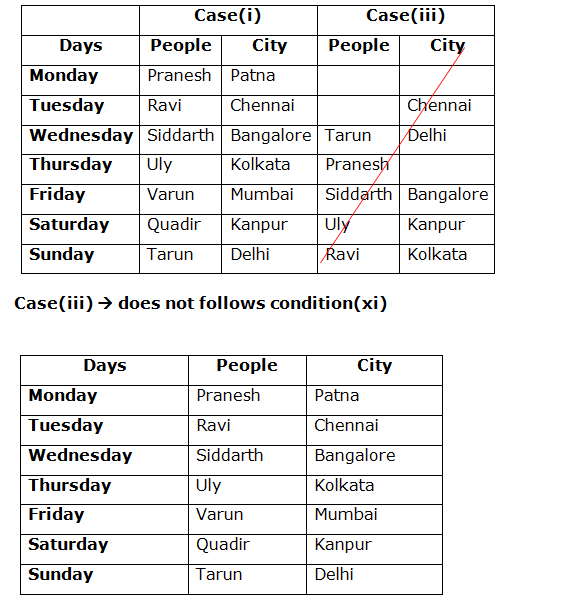
- Answer: D
- Answer: B
- Answer: A
- Answer: B
- Answer: E
- Answer: CExplanation: P < L ≥ C ≤ V > N ≤ R = S ≤ O
N ≤ R = S ≤ O à (N ≤ O) so, Either Conclusion I or Conclusion II follows
- Answer: DExplanation: M ≤ N = F > O < P ≥ S ≤ L > K
I). M ≤ N = F > O < P ≥ S (False)
II). N = F > O < P ≥ S ≤ L > K (False)
- Answer: EExplanation: P > L ≥ M = N ≥ H ≤ B = V ≤ W
I). H ≤ B = V ≤ W (True)
II). P > L ≥ M = N ≥ H (True)
- Answer: BExplanation: H > S < O ≥ E = N ≤ X < L ≥ V > Q
I). O ≥ E = N (False)
II). L ≥ V > Q (True)
- Answer: AExplanation: P < L = C < J ≥ I > U ≥ S ≤ X > Q
I). J ≥ I > U ≥ S (True)
II). P < L = C (False)
Direction (11-15):
Explanation:

i). D sits third to the right of Vacant seat.
ii). Only one seat between A and C, who neither faces S nor P.
iii). Only one person sits between A and B.
iv). R sits second to the left of Vacant seat.
v). Only one person sits between S and Q, who does not faces A.
vi). P does not faces D.
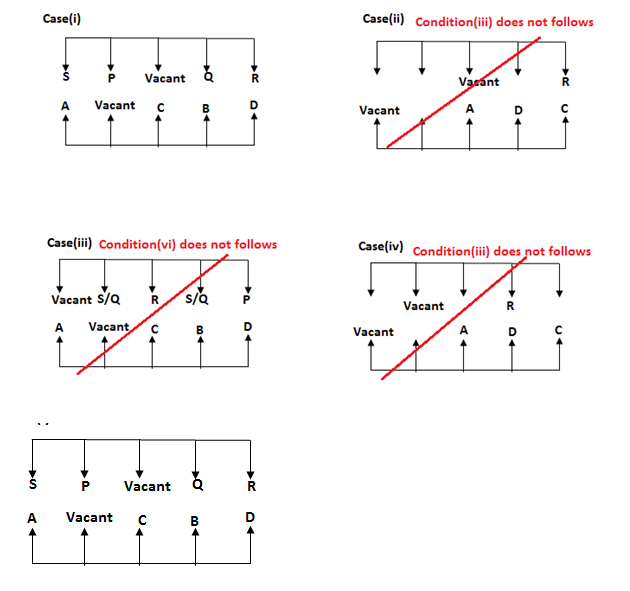
11. Answer: E
12. Answer: B
13. Answer: C
14. Answer: C
15. Answer: B
Direction (16-18):
Explanation:
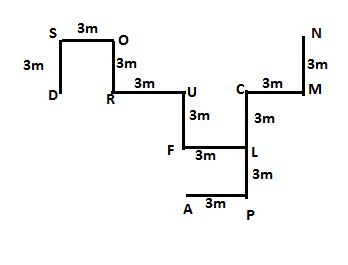
16. Answer: C
17. Answer: A
18. Answer: D
Direction (19-20):
Explanation: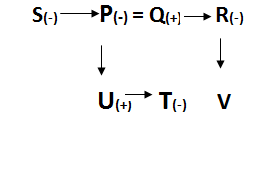
19. Answer: A
20. Answer: D
Daily Practice Test Schedule | Good Luck
| Topic | Daily Publishing Time |
| Daily News Papers & Editorials | 8.00 AM |
| Current Affairs Quiz | 9.00 AM |
| Quantitative Aptitude “20-20” | 11.00 AM |
| Vocabulary (Based on The Hindu) | 12.00 PM |
| General Awareness “20-20” | 1.00 PM |
| English Language “20-20” | 2.00 PM |
| Reasoning Puzzles & Seating | 4.00 PM |
| Daily Current Affairs Updates | 5.00 PM |
| Data Interpretation / Application Sums (Topic Wise) | 6.00 PM |
| Reasoning Ability “20-20” | 7.00 PM |
| English Language (New Pattern Questions) | 8.00 PM |





